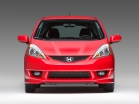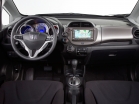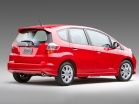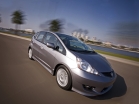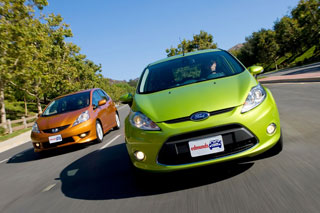Honda Fit 2008 - 2010 test drive
Honda Fit Aria car review
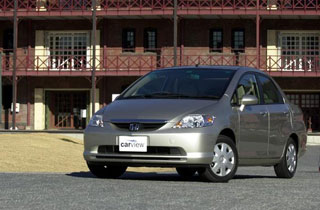 General
General The Honda Fit Aria car is the third (or perhaps fourth) attempt to use a platform with a fuel tank located in the middle in the car. Prior to this, there were invariably well -sold Honda Fit, Mobilio, Mobilio Spike. As you can judge by photographs, Fit Aria is a 3-volume sedan. But, since the sedan market is continuously reduced in Japan, it was called a 1-liter class sedan. The car itself was in the same team with the product of the Toyota company Platz.
What else should pay attention to is that the car is assembled at a factory in Thailand. Thus, this is actually an imported car. The ARIA model was the second car of the City class of the City Class company, made as part of the Asian policy program it adopted. The essence of this policy is to provide each family with one car, not only in Thailand, but also in other countries of Asia. And the main emphasis is on a place on a car like sedan. In Japan, experts predict, this sedan will not be in such demand as, for example, a FIT model like hatchback. Given this circumstance, as well as the fact that the plant in Thailand, modern production launched only in December 2000, seems logical to our age without borders to organize the release of Fit Aria there. Thailand, who has already managed to call the Asian Detroit, turned out to be a kind of Mecca for world car manufacturers. And in order to verify the high quality of the assembly, it is enough to note that in the same place, in Thailand, the Subaru Traviq car is also assembled. By the way, now such times have come that even Mercedes C-Class, designed for sale in Japan, is not produced somewhere, but in South Africa. So the question is: in which country is this car produced? - It becomes secondary by and large.
In Japan, such a car will not be successful? But what about the similar model of Toyota? After all, the volume of its monthly sale is neither more nor less, and on average about 3 thousand pieces, or about 30 thousand per year. And on the other hand, we should not forget that the Honda Fit car was able to destroy the 33-year dominance of the Corolla model in terms of annual sales, and now, as everyone believes, is preparing strength in order to protect its conquests in 2003! Or maybe this is why the new machine is called not just ARIA, but FIT ARIA? However, this is a free interpretation of events presented by the observer, and nothing more. Although everything can be!
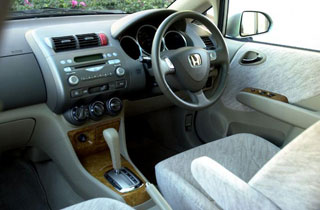 Brilliant design of secondary details
Brilliant design of secondary details Speaking about the main features of the ARIA car layout, it should be noted that the FIT car was the base for it, and its interdosa distance is 2450 mm. He also had a huge trunk. Of course, it was necessary to balance it according to the new (after all the sedan), so the developers had to reduce its height by 40 mm in comparison with the basic Fit model and make it equal to 1485 mm (in a front-wheel drive machine). The length of the car is ARIA 4310 mm, which is 130 mm more than the competitor of the Toyota Platz model. But this is due to the differences between the Honda Fit and Toyota Vitz model. Further, the beneficial volume of the trunk, which is now not interfering with the fuel tank, is 500 liters. For comparison: the Toyota Platz model is 464 liters, the Suzuki Aerio Sedan car is 492 liters. Perhaps, on this basis, Honda’s new model of Honda can be ranked to leaders in its class. And yet, in the rear seats, a design was used, which has proven itself in the Honda Fit car and which provides for laying the chair down in one movement (One Touch Dive Down) and the rise of the seat. However, it has some differences from the basic option, due to the need to adapt these seats for installation in a car in a car type. But, nevertheless, except that the backs of the seats do not deviate back, all their other beneficial properties are preserved. So we can say with confidence that this knot is thought out with greater care than it took place in the Toyota Premio / Allion car.
As you know, the basic model of the Honda Fit car, in the shape of the body gravitates to the class of minivans. Therefore, it was not easy to take the basic shape of the windshield and integrate this glass into the sedan. Nevertheless, this was successfully done, and now, looking at the contours of the new car, especially at the low line of the roof, you begin to come up with unusual phrases, for example, the minivan (?). And they do not seem so unnatural, that’s the matter! The front lining is also different from the Honda Fit car mask. In particular, its somewhat moderate design is noteworthy, which is achieved thanks to the brilliant, contrasting headlights. By the way, the Platz vehicle’s front of the car after low modernization also began to look. The interior design used mainly elements borrowed from the FIT machine, although the color scheme has become more muffled. In addition, a niche under a box for storing gloves (a glove compartment) here is covered with a lid. There are some more details that are skillfully introduced into the salon, and which are due to the desire of designers to provide the owner with the maximum
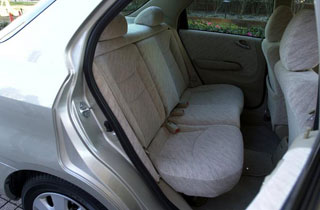 opportunities for the neat distribution of all graters in their places. This, supposedly, should meet the secret desires of the category of buyers who, when purchasing a car of this class, opt for the sedan. Due to the special line of the roof, the back of the cabin has a low ceiling, so the head of the passenger sitting in the back seat may be under the influence of sunlight. At the same time, even with my height of 178 cm I can, sitting in this chair, at least somehow move the body down, that in other, even recently released models of domestic cars, it was impossible.
opportunities for the neat distribution of all graters in their places. This, supposedly, should meet the secret desires of the category of buyers who, when purchasing a car of this class, opt for the sedan. Due to the special line of the roof, the back of the cabin has a low ceiling, so the head of the passenger sitting in the back seat may be under the influence of sunlight. At the same time, even with my height of 178 cm I can, sitting in this chair, at least somehow move the body down, that in other, even recently released models of domestic cars, it was impossible. Enviable torque at low speed
The machine is equipped with an engine of two types: 1.3-liter and 1.5-liter, but even a 1.5-liter engine (I-DSI) is not equipped with a VTEC gas distribution system with automatically changed phases and valve opening. The transmission is only unfavorable, although in modification with a 1.5-liter engine provides for a 7-speed switching mode. Thanks to a powerful torque at low speed, even a machine with a 1.3 -liter engine does not lack traction. And, at the same time, such a modification is inexpensive in price. In addition, the inner part of the cabin, where the front panel is painted in a metal color, and the dashboard is made in the form of annual rings, looks more youthful than the interior of the modification with a 1.5-liter engine, and is more consistent with the style of the Aria car. The suspension of controlled wheels is adjusted in such a way as to achieve an elegant move that is natural for the sedan. Management, if it cannot be compared specifically, transplanting from the car to the car, seems to be no different from the control of the FIT car, while I judge by my sensations, there is almost no difference between a 1.3-liter and 1.5-liter modification.
By the way, the ARIA model has a relatively strict suspension, so the irregularities of the road are transmitted to the body quite noticeably. In return this, the car holds posture well on the move, which also gives considerable pleasure. I believe, at the same time, that the tire size moderate by the standards of the Honda style and the nature of the suspension are not quite combined with each other, so there is still something to reflect on the developers. Speaking briefly, the suspension is made in such a way as to prevent excessive roll, and tires
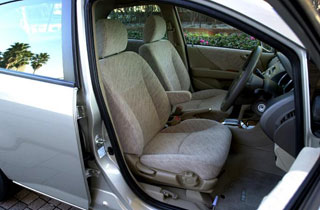 in this regard, they have excessively low K.P.D. Of course, machines of this class should not be up to the impossibility of increasing the strength of tires with the road surface. But it would be more correct, on the other hand, to allow the body to roll to such an extent that the driver has the opportunity to pre -determine the onset of a critical moment in the behavior of the wheels. With the current adjustment of the suspension, the car goes without a roll and it seems that the critical corner is still far away, and suddenly the tires, and only they begin, as they say, to bend and lose the adhesion to the road. I think that potential buyers of the ARIA car are those who evaluate the car from a utilitarian point of view on the principle of a car vehicle. Or, if my thought is more understandable, there is a large group of drivers among the buyers who, not being confident in their abilities, want to drive a car that is being easily, and nothing more. And therefore, I think they need such a machine that, without waiting for the tires to lose the traction with the road, will be signaling in advance sitting at the wheel that the speed is on the verge.
in this regard, they have excessively low K.P.D. Of course, machines of this class should not be up to the impossibility of increasing the strength of tires with the road surface. But it would be more correct, on the other hand, to allow the body to roll to such an extent that the driver has the opportunity to pre -determine the onset of a critical moment in the behavior of the wheels. With the current adjustment of the suspension, the car goes without a roll and it seems that the critical corner is still far away, and suddenly the tires, and only they begin, as they say, to bend and lose the adhesion to the road. I think that potential buyers of the ARIA car are those who evaluate the car from a utilitarian point of view on the principle of a car vehicle. Or, if my thought is more understandable, there is a large group of drivers among the buyers who, not being confident in their abilities, want to drive a car that is being easily, and nothing more. And therefore, I think they need such a machine that, without waiting for the tires to lose the traction with the road, will be signaling in advance sitting at the wheel that the speed is on the verge. All modifications of the Fit Aria car are equipped with standard tires of the above size. And even among additional accessories, only 14 inches aluminum discs are included. If I decided to purchase such a car, I would immediately change the wheels to the size of 15 inches. Yes, and for tires I would choose something moreatical (but not tires for a pronounced sports manner of driving). I think that after these events the character of the machine would have become a little different in the sense that it would unexpectedly become a sedan of sports orientation.
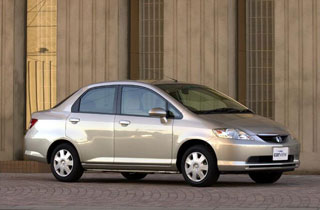
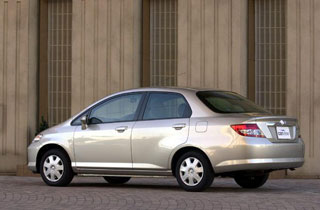
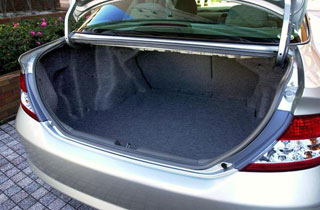
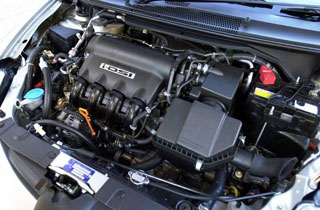
Source: CarView.co.jp

